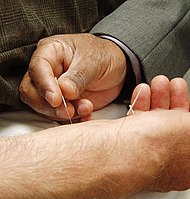
Photo from wikipedia
BACKGROUND Evidence showed that early palliative care could have many benefits in clinical outcomes for patients living with advanced medical illnesses. In fact, most of these studies have not involved… Click to show full abstract
BACKGROUND Evidence showed that early palliative care could have many benefits in clinical outcomes for patients living with advanced medical illnesses. In fact, most of these studies have not involved patients with advanced haematologic cancer (HC), which are known to be associated with significant physical and psychological symptoms. In Hong Kong, an Early Integrated Palliative Care (EIPC) collaboration involving both Heamatology unit of Queen Mary Hospital (QMH) and the Palliative Medical Unit of Grantham Hospital (GH) has been started since early 2018 as a better way to improve the service gap. The HC patients failed 2 or more lines of cancer treatment are identified during the joint round and hematology clinic. Some of these patients will be referred to our PC services. Our joint PC clinic has multidisciplinary input from palliative care physicians, hematologists, and clinical psychologists. The clinic program is well coordinated and structured. The HC patients are initially seen by the parent team for disease treatment and then by GH PC team for symptom control and psychosocial care. METHODS This was a retrospective study with a review of the clinical charts and electronic healthcare records of all patients who attended the Hematology PC clinic from June 2018 to September 2020. For the inclusion criteria, patients were found eligible if they had prospectively completed Edmonton Symptom Assessment Scale (ESAS) assessments for at least the initial and follow-up visits within a range of ≥7 days and ≤60 days of the first visit. RESULTS Thirty-eight patients ultimately agreed to the referral. The mean age was 70.5 (12.5) years old. Twenty-five patients (66%) had myelodysplastic syndrome (MDS); 10 (26%) had acute myeloid leukemia (AML). Around 50-60% of patients reported significant symptoms of fatigue, anxiety, drowsiness, and anorexia; 42% of patients had significantly depressed moods while 37% had pain. There were significant symptom improvements for pain, depression, and anxiety after follow-up visits. CONCLUSIONS The study showed that our EIPC program resulted in a significant reduction in some of the important symptom item scores, including pain, anorexia, anxiety, and depression, after the follow-up visits.
Journal Title: Annals of palliative medicine
Year Published: 2021
Link to full text (if available)
Share on Social Media: Sign Up to like & get
recommendations!